23 Types of Geese Breeds: An Overview (with Pictures)
Last Updated on
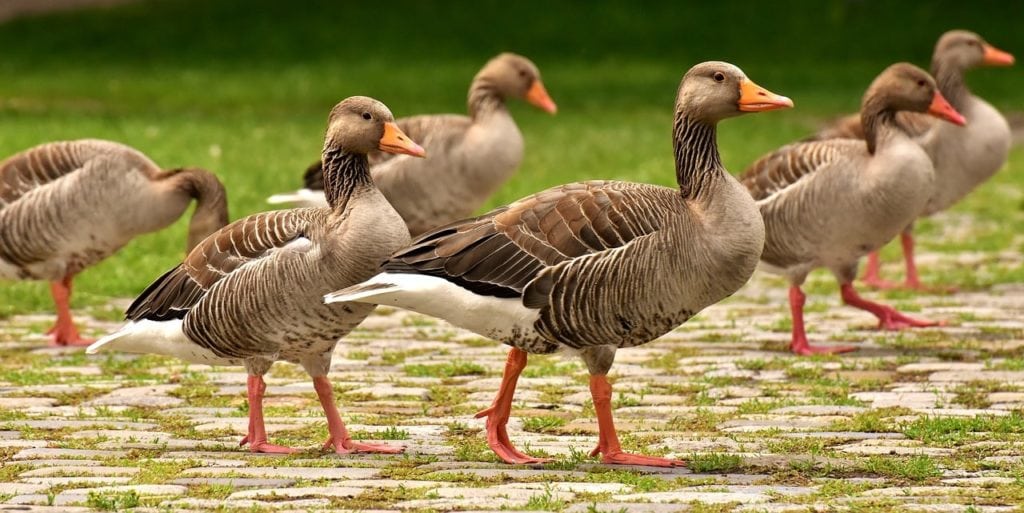
When you think of a goose, you might have a traditional species in mind depending on where you live on the globe. They inhabit practically every area on earth except Antarctica—and each one has some pretty interesting physical attributes.
Here are 23 geese breeds with explanations of what each one is all about.

The 23 Types of Geese Breeds:
1. African Geese

| Scientific Name: | Cygnoides domesticus |
| Origin: | China |
| Appearance: | Brown |
| Weight: | 18 – 20 pounds |
| Height: | 3 feet |
| Lifespan: | 10 – 15 years |
Despite its name, the African goose is a domestic breed thought to come from China. These geese are derived from the wild swan but look significantly different now. These birds are heavy with muscular bodies, making them ideal table birds. These birds are often used for roasting.
Many keepers prefer this goose because it is very hardy and resilient in extreme weather. You can have them in virtually any farm setting as long as they have adequate fresh food and water supply.
2. American Buff Geese
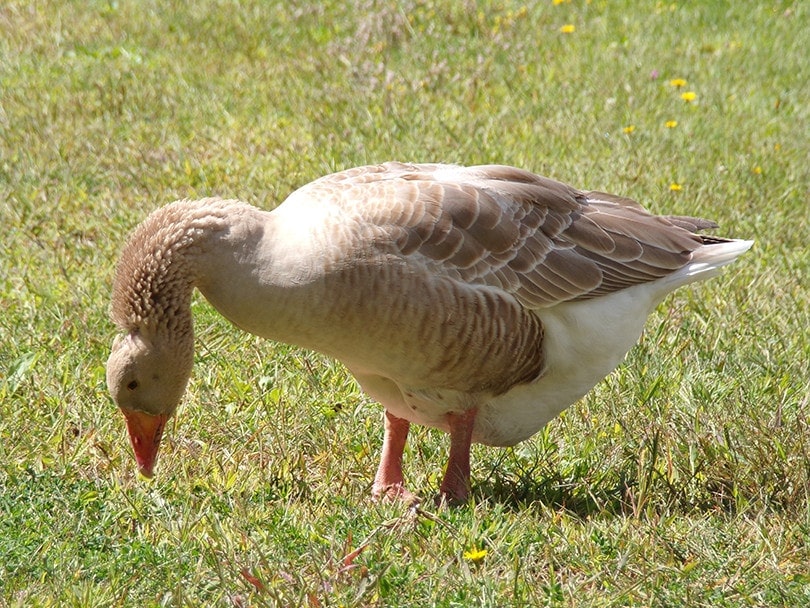
| Scientific Name: | Anser anser domesticus |
| Origin: | United States |
| Appearance: | Buff |
| Weight: | 20 pounds |
| Height: | 3 feet |
| Lifespan: | 15 – 20 years |
Recognized by the American Poultry Association in 1947, the American buff goose is a US native. This traditional-looking farm goose comes in shades between fawn and apricot—hence the name. This dual-purpose bird is prized for both meat and egg production.
3. Andean Geese
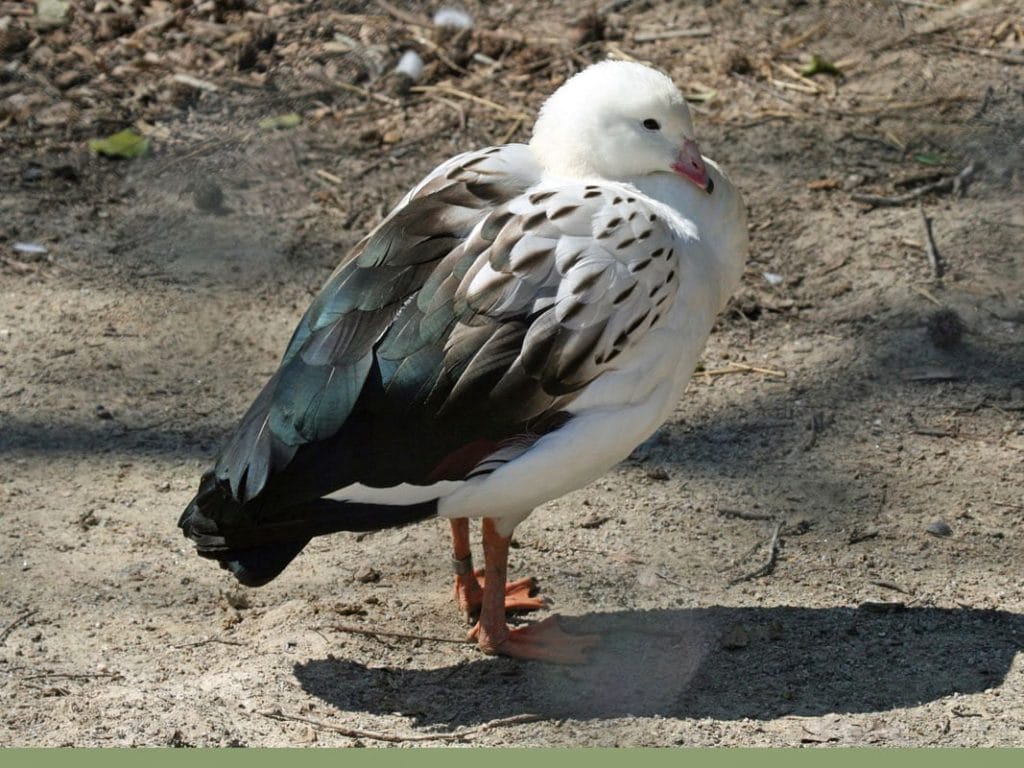
| Scientific Name: | Chloephaga melanoptera |
| Origin: | South America |
| Appearance: | Black and white |
| Weight: | 6 – 7 pounds |
| Height: | 27.5 – 31.5 inches |
| Lifespan: | 10+ years |
The Andean goose is a chunky little black and white bird that lives in bogs and on lakeshores. They have distinguishing pink legs and short beaks, so they are quite recognizable in their native regions. Contrary to what you might think, these birds are terrestrial and don’t enjoy swimming.
Even though Andean geese are not dimorphic, they do make noticeably different noises. Males make whistling sounds while females grunt—so tones are much lower.
4. Ashy-Headed Geese

| Scientific Name: | Chloephaga poliocephala |
| Origin: | South America |
| Appearance: | Brown, black, white |
| Weight: | 4 – 5 pounds |
| Height: | 20 – 22 inches |
| Lifespan: | 10 – 25 years |
The strangely beautiful ashy-headed goose is native to parts of South America.
The strangely beautiful ashy-headed goose is native to parts of South America. These geese are considered sheldgoose, living in pairs or small groups across wetlands, lakes, and gentle rivers. These geese are typically found in areas of Chile and Southern Argentina.
These geese might be called ashy-headed, but you might immediately notice the bright rusty color around the neck and zebra-striped pattern on the wings. These geese truly are a beautiful sight to see.
5. Bar-Headed Geese
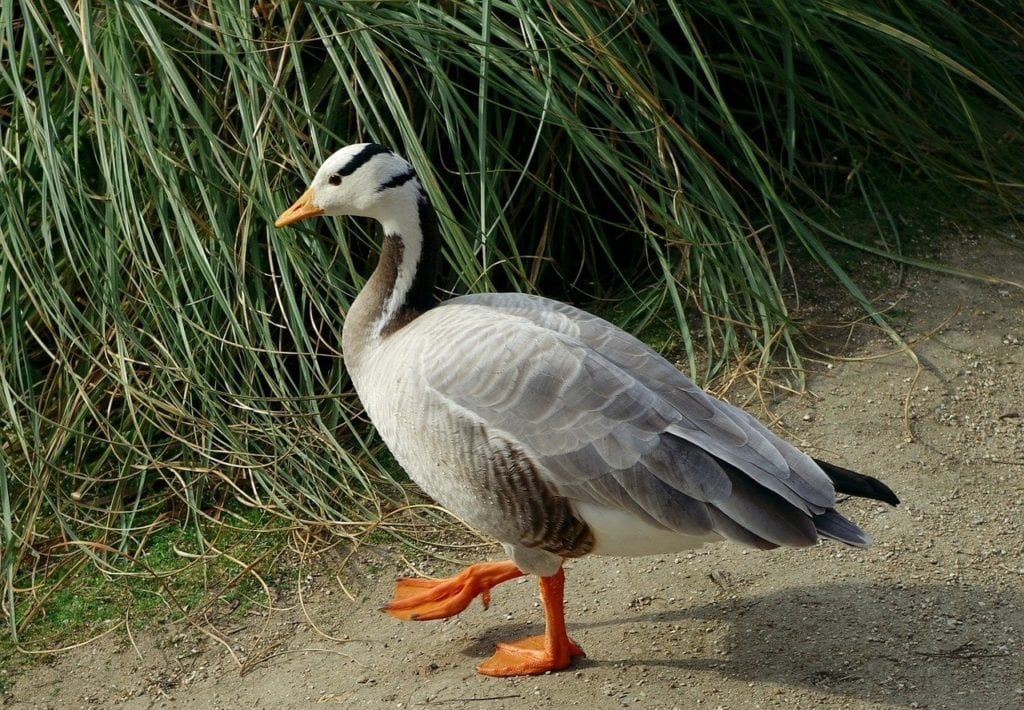
| Scientific Name: | Anser indicus |
| Origin: | Asia |
| Appearance: | Brown and white |
| Weight: | 4 – 7 pounds |
| Height: | 26 – 28 inches |
| Lifespan: | 15 years |
Bar-headed geese are large Asian birds with beautifully intricate markings. They spend their time in Central Asia in the summer months, flying south to India during the winters. Unlike some geese species, these waterfowl are particularly mild-tempered.
Bar-headed geese are especially talented flyers. They’re practically famous for their extreme altitudes in the Himalayas and Tibet. They can fly up to 7,270—which is astonishing.
6. Barnacle Geese
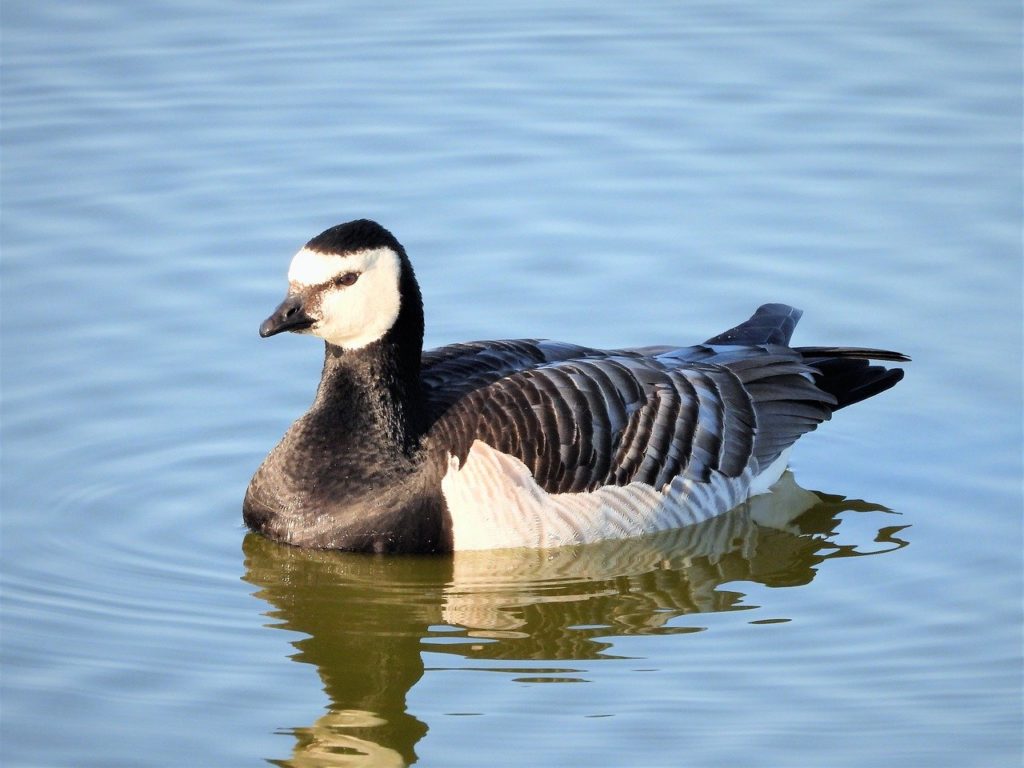
| Scientific Name: | Branta leucopsis |
| Origin: | Arctic, North Atlantic |
| Appearance: | Gray, black |
| Weight: | 3 – 4 pounds |
| Height: | 22 – 28 inches |
| Lifespan: | 25 years |
The lovely barnacle goose, not to be confused with goose barnacles, is a large black and gray goose from the world’s colder regions. These geese inhabit coastal regions and salt marshes. While they’re mostly vegetarian, they will eat some mollusks, crustaceans, and insects.
During warmer months, the barnacle goose hangs out with a large flock that creates quite a symphony. They are quite social birds who get along with each other and don’t mind people too much.
7. Bean Geese
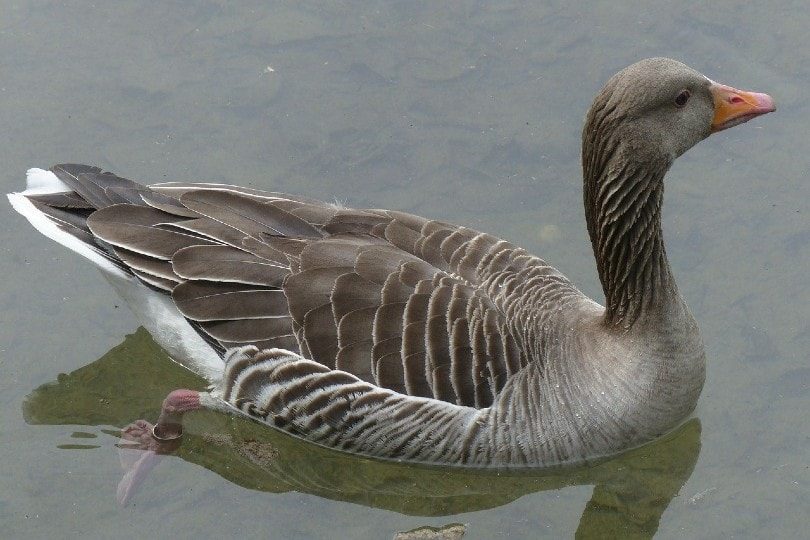
| Scientific Name: | Anser fabalis |
| Origin: | Europe, Asia |
| Appearance: | Tan, black |
| Weight: | 6 pounds |
| Height: | 27 – 35 inches |
| Lifespan: | 25 years |
Bean geese are naturally found in Europe and Asia—two of which are distinctly different—one living in the tundra, one living in taiga. Unlike many geese, these birds are strict vegetarians, feasting on plant material like grasses, seeds, and tubers.
The bean goose is a pretty standard-looking fellow, lightly colored in neutrals with black on the tail. They are generally relaxed and pleasant.
8. Blue-Winged Geese

| Scientific Name: | Cyanochen cyanoptera |
| Origin: | Ethiopia |
| Appearance: | Tan, blue, black |
| Weight: | 5 – 6 pounds |
| Height: | 25 – 29 inches |
| Lifespan: | 15 years |
Blue-winged geese are native to Ethiopia, lounging on the banks and highlands of lakes. These birds are primarily herbivorous but will resort to eating small insects and larvae. This species is thought to be declining in its natural habitat.
The blue-winged goose gets its name, as you can imagine, from the dusty blue part on its hindquarters. They are otherwise light brown and tall with neutral markings. Both sexes are the same color, but males are generally larger than their female counterparts.
9. Brent Geese

| Scientific Name: | Branta bernicla |
| Origin: | Siberia, Europe |
| Appearance: | Bold chocolate, brown |
| Weight: | 2.5 – 3.5 pounds |
| Height: | 22 – 26 inches |
| Lifespan: | 12 – 27 years |
Brants are unique small geese that are a similar size to a standard duck. These chocolate-colored geese have a mechanism in their mouths that allows them to swallow saltwater, so they rarely ever trail away from salt marshes and estuaries.
Brant’s are real migratory achievers. These flocks can fly up to 3,000 miles in one trip. After such a journey, these birds take a while to revamp their body weight and recover from the calorie loss, but many of them manage it every year.
10. Canada Geese
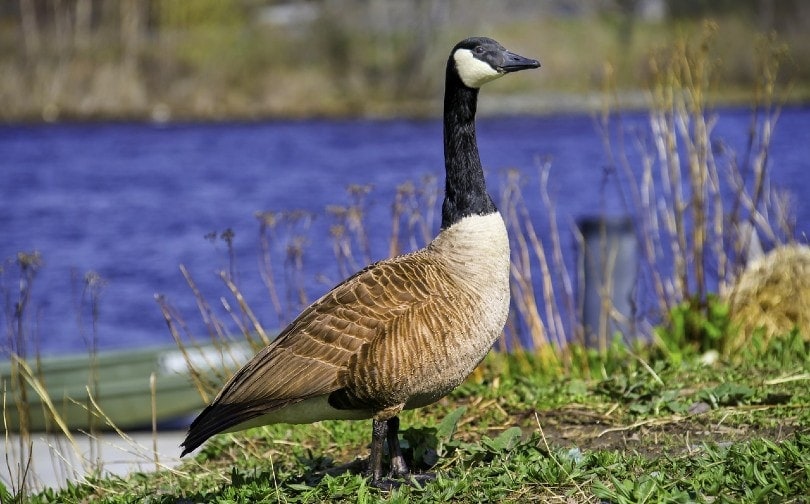
| Scientific Name: | Branta candadensis |
| Origin: | North America, Europe |
| Appearance: | Black, brown, cream |
| Weight: | 5.5 – 14 pounds |
| Height: | 30 – 43 inches |
| Lifespan: | 10 – 20 years |
Canada geese love flocking in large groups and hanging out by a still water source like a pond or lake. You can find these geese simply riddled all over North America and occasionally in Europe during migration. Many of these birds travel in bloodlines and families.
Canada geese hold records for potentially being the meanest of all geese. These beauties might be lovely, but look and don’t get close—especially not during the breeding season. The males can get super territorial and aggressive.
11. Cape Barren (Coreopsis) Geese

| Scientific Name: | Coreopsis novaehollandiae |
| Origin: | Australia |
| Appearance: | Dusty tan to gray |
| Weight: | 7 – 15 pounds |
| Height: | 30 – 40 inches |
| Lifespan: | 20 years |
The cape barren is a stunningly large goose with an ashy feathering. Unlike many of their goose cousins, cape barrens are herbivores, feasting only on native plants and local green favorites.
Large but elegant, these geese have sizable bodies with a confident stride. Their heads are narrow, making it look as though the head might be too small for the rest of the body—but it adds to the beauty and charm of the breed.
12. Chinese Geese
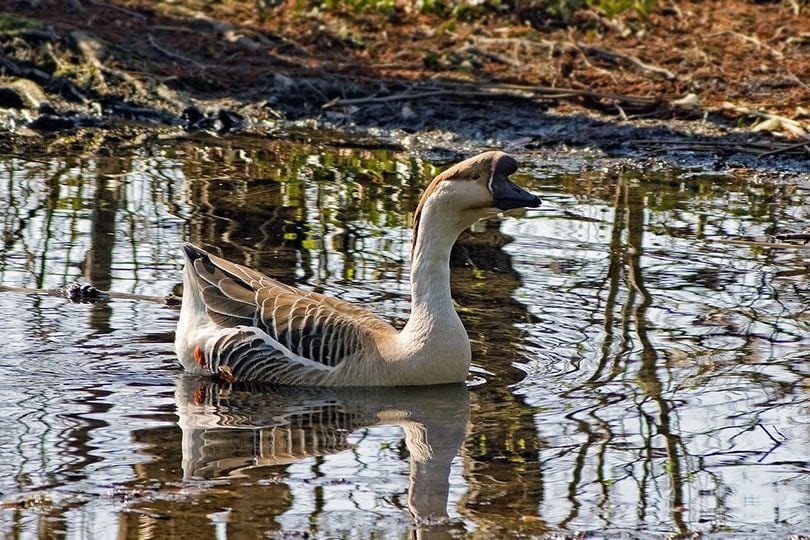
| Scientific Name: | Anser cygnoides |
| Origin: | China |
| Appearance: | Brown, white |
| Weight: | 11 – 20 pounds |
| Height: | 24 – 36 inche |
| Lifespan: | 10 – 15 years |
The Chinese goose is a domestic breed from China that has a captivating appearance. Unlike many geese, these birds are master layers, producing up to 100 eggs per year.
The Chinese goose is a really cool waterfowl, getting up to three feet tall and sporting a huge bump on its beak. They are traditionally similar to all the anser anser, or domesticated geese, ranging from white to various shades of brown.
13. Roman Tufted Geese

| Scientific Name: | Anser anser |
| Origin: | Domestic |
| Appearance: | White |
| Weight: | 6.5 – 7.5 pounds |
| Height: | 12 – 14 inches |
| Lifespan: | 25 years |
The Roman tufted goose, or crested duck, has a unique appearance, touting a cotton ball-like fluff on their crown. Originally, this significant breed feature was a deformity in the bloodline that was expanded upon.
These geese are docile and calm with agreeable personalities. They tend to be fragile but otherwise easy to keep. They are pretty exceptional layers, too—numbers up to 130 annually.
14. Egyptian Geese
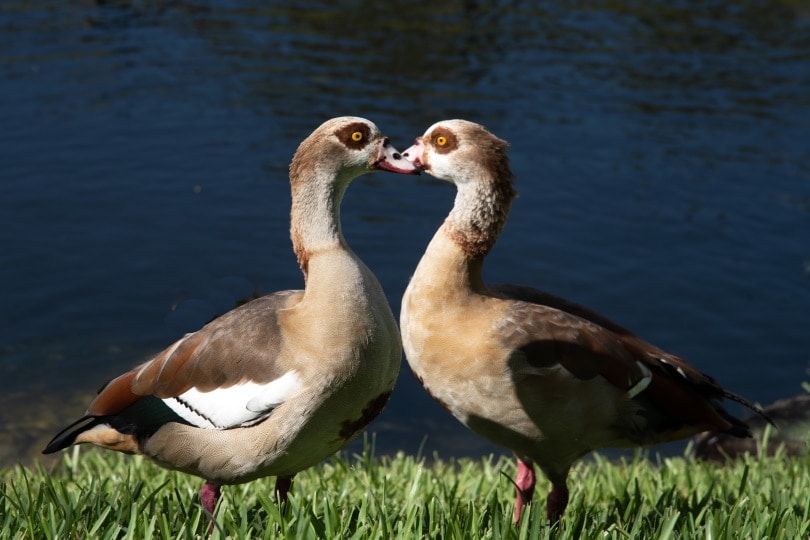
| Scientific Name: | Alopochen aegyptiaca |
| Origin: | Africa |
| Appearance: | Auburn, brown |
| Weight: | 3.3 – 5 pounds |
| Height: | 25 – 28 inches |
| Lifespan: | 15 – 20 years |
Egyptian geese are inhabitants of grasslands and open water across Africa. It isn’t unusual to see them occupy ornamental ponds or populated lakes. These birds enjoy lots of plant material, as they are predominantly herbivorous.
These birds are decently large, slender, and graceful with long, pink legs. During mating season, the males can get highly aggressive, so it’s best to stay away.
15. Emperor Geese

| Scientific Name: | Anatidae canagicus |
| Origin: | Russia/Alaska |
| Appearance: | Black, gray |
| Weight: | 4 – 5 pounds |
| Height: | 26 – 28 inches |
| Lifespan: | 6 – 12 years |
The emperor goose absolutely loves chilly weather, inhabiting many arctic and subarctic areas of the Bering Sea. They enjoy freshwater pools and other slow or still water sources.
The emperor goose is a bird that stands out from the crowd with bright yellow legs, a black and white patterned body, and a snow-white neck and head. Unfortunately, goslings have a very high mortality rate due to local predators.
16. Greylag Geese

| Scientific Name: | Anser anser |
| Origin: | Europe |
| Appearance: | Ash gray, black |
| Weight: | 7 – 9 pounds |
| Height: | 29 – 36 inches |
| Lifespan: | 20 – 30 years |
Greylag geese are an ancient breed of domesticated goose, predating 1360 BC. These historically famous birds are even featured in old Egyptian paintings showing off their pink legs. These geese usually eat both land and aquatic plant matter.
The graylag goose is ashy gray with black bands and white tips. They have bright orange beaks and pink legs to contrast their feathering.
17. Kelp Geese

| Scientific Name: | Chloephaga hybrida |
| Origin: | South America |
| Appearance: | White, black, gray |
| Weight: | 7 – 8 pounds |
| Height: | 22 – 26 inches |
| Lifespan: | 10 – 15 years |
Hailing from South America, the kelp goose is a very recognizable specimen. It has an odd shape, almost like a large pigeon. These interesting little waterfowl live along rocky coasts and freshwater lakes.
18. Magpie Geese

| Scientific Name: | Anseranas semipalmata |
| Origin: | Australia |
| Appearance: | Black, white |
| Weight: | 6 – 7 pounds |
| Height: | 30 – 35 inches |
| Lifespan: | 20 years |
The magpie goose is a highly peculiar and lovely bird, native to Australia. These birds are wanderers at heart, often caught outside of their typical parameters after breeding season. These birds are relatively common in the land down under.
These waterfowl have long, upright bodies with crane-like heads. They sport lovely sun-kissed coloring and have long, powerful legs to travel through wading water.
19. Nene/Hawaiian Geese

| Scientific Name: | Branta sandvincensis |
| Origin: | Hawaii |
| Appearance: | Brown, tan, black |
| Weight: | 3 – 6 pounds |
| Height: | 15 – 16 inches |
| Lifespan: | 8 – 20 years |
The nene is a medium-sized goose found in Hawaii. These social geese aren’t shy—as they inhabit untouched land and human-made alike. They prefer living in grasslands, shrublands, and lava plains—but they also take advantage of farmland resources.
The nene often sports shades of brown with a distinct black head and eyes. These birds have powerful bodies and are shaped much like their Canada geese cousins, only smaller.
20. Pink-Footed Geese

| Scientific Name: | Anser brachyrhynchus |
| Origin: | Europe |
| Appearance: | Tan, white |
| Weight: | 5 – 6 pounds |
| Height: | 24 – 30 inches |
| Lifespan: | 20 years |
As the name would imply, these birds are named after their pink feet. The pink-footed goose is incredibly rare and lovely, scattered all over Europe in areas like Greenland, Denmark, Iceland, and Svalbard.
The pink-footed goose is often mistaken for the graylag, as they look incredibly similar. However, the graylag is domesticated, and the pink-footed goose is not.
21. Red-Breasted Geese

| Scientific Name: | Branta rufficollis |
| Origin: | Eurasia |
| Appearance: | Chestnut, black, white |
| Weight: | 3 – 4 pounds |
| Height: | 20 – 22 inches |
| Lifespan: | 15 years |
The red-breasted goose is a highly versatile waterfowl living in grasslands, wetlands, coastal plains, and terrestrial areas in Eurasia. These geese are vegetarians, snacking on local grass leaves, cotton grass, winter wheat, and herbs.
The red-breasted goose is thought of as one of the prettiest geese species of all. They have deep chestnut-colored heads, black and white feathering that is super sleek and shiny.
22. Sebastopol Geese

| Scientific Name: | Anser anser |
| Origin: | Domesticated |
| Appearance: | White |
| Weight: | 12-14 pounds |
| Height: | 30-32 inches |
| Lifespan: | 25 years |
The Sebastapol goose is a domesticated breed of waterfowl that was created for its spectacular appearance. These angelic geese have free-flowing wispy white feathers and heavy bodies with bright blue eyes.
They are lovely to have on the farm and they tend to be quite cold hardy. They are purely ornamental, but they lay up to 30 large white eggs per year. This breed is exceptionally rare.
23. Snow Geese

| Scientific Name: | Chen |
| Origin: | Canada |
| Appearance: | White, black |
| Weight: | 4 – 6 pounds |
| Height: | 25 – 33 inches |
| Lifespan: | 6 – 15 years |
The snow goose is a lovely waterfowl that build colonies in Canada and Alaska. These geese love the arctic tundra, spending their time in saltwater marshes and bays. These geese are herbivores finding most of their nutrients in water-logged areas.
This goose is small with sleek white feathers and black on the tail. Their beak and legs are orange and their bodies are proportionate. There is both a greater and lesser snow goose that differ slightly in body makeup, but not to the untrained eye.

Conclusion
That’s not all—there are many more waterfowl unexplored. As you can see, there is so much variety spanning out across the globe in just one species. These water lovers are generally monogamous and typically quite aggressive to anyone threatening their families.
Next time you’re at a local pond, you might try spotting one of these remarkable species out in the area you live.
Featured Image Credit: Alexas_Fotos, Pixabay
Table of Contents
- The 23 Types of Geese Breeds:
- 1. African Geese
- 2. American Buff Geese
- 3. Andean Geese
- 4. Ashy-Headed Geese
- 5. Bar-Headed Geese
- 6. Barnacle Geese
- 7. Bean Geese
- 8. Blue-Winged Geese
- 9. Brent Geese
- 10. Canada Geese
- 11. Cape Barren (Coreopsis) Geese
- 12. Chinese Geese
- 13. Roman Tufted Geese
- 14. Egyptian Geese
- 15. Emperor Geese
- 16. Greylag Geese
- 17. Kelp Geese
- 18. Magpie Geese
- 19. Nene/Hawaiian Geese
- 20. Pink-Footed Geese
- 21. Red-Breasted Geese
- 22. Sebastopol Geese
- 23. Snow Geese
- Conclusion
About the Author Ashley Bates
Ashley Bates is animal writer and enthusiast who is currently studying the art of animal therapy. A mother to four human children— and 23 furry and feathery kids, too – Ashley volunteers at local shelters, advocates for animal well-being, and rescues every creature she finds. Ashley's mission is to create awareness and education about animals of all shapes and sizes to promote proper care and respect.
Related Articles:
Monocular vs Telescope: Differences Explained (With Pictures)
10 Types of Hummingbirds in Arkansas (With Pictures)
8 Types of Hummingbirds in Nebraska (With Pictures)
5 Types of Hummingbirds in Idaho (With Pictures)
3 Types of Hummingbirds in Mississippi (With Pictures)
8 Types of Hummingbirds in Kansas (With Pictures)
5 Types of Hummingbirds in West Virginia (With Pictures)
5 Types of Hummingbirds in Ohio (With Pictures)
